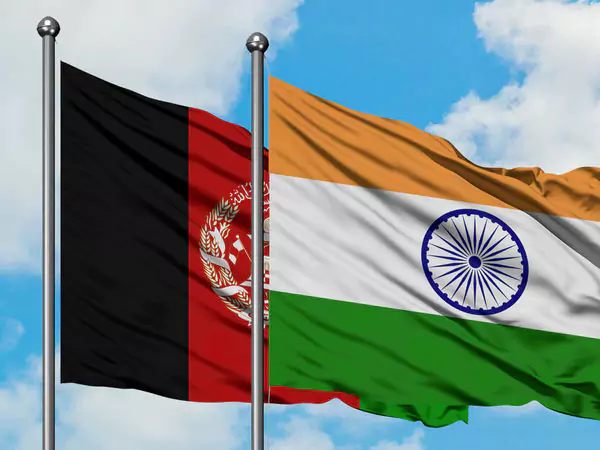INDIA Balancing Strategic Interests in South Asia: India’s Stand on
the Taliban and Afghanistan’s Future
India’s policy toward Afghanistan under the Taliban regime reflects a
delicate balance between economic engagement, security interests, and
regional stability. This analysis explores the historical context,
strategic calculations, and future scenarios shaping
India's approach. The complexity of India's relationship with the Taliban stems from the
Taliban's ties with Pakistan, the growing influence of
China, and the geopolitical importance of Afghanistan as a
strategic hub connecting South Asia with Central Asia.
Historical Context and India’s Strategic Legacy in Afghanistan
Historical Background
India has maintained deep cultural, economic, and political ties with
Afghanistan for centuries. However, these ties have been strained by the Taliban’s
previous rule (1996–2001) and its historic alignment with Pakistan. India
supported the Northern Alliance against the Taliban in the 1990s and
maintained close ties with the post-2001 governments of Hamid Karzai
and Ashraf Ghani.
| Period |
Key Developments |
India’s Role |
| 1979–1989 |
Soviet-Afghan War |
Supported Soviet-backed Afghan
factions |
| 1996–2001 |
Taliban Regime |
Opposed Taliban; supported the
Northern Alliance |
| 2001–2021 |
US-led NATO Occupation |
Major investor in Afghan
infrastructure and political stability |
| 2021–Present |
Taliban Regime |
Gradual re-engagement without formal
recognition |
Why Afghanistan Matters to India
- Strategic Location – Afghanistan serves as a vital land
bridge between South Asia and Central Asia.
- Security Threat – Taliban's ties with Pakistani intelligence
(ISI) and terrorist organizations (LeT, JeM) raise the risk of terrorism in Kashmir.
- Economic Potential – Afghanistan holds significant natural
resources (copper, lithium) and trade opportunities.
- Regional Stability – Political instability in Afghanistan
could destabilize South Asia.
- Counterbalance to Pakistan and China – Engagement with the
Taliban prevents Afghanistan from becoming a Pakistan-China geopolitical asset.
India’s Strategic Goals in Afghanistan
- Regional Security and Counterterrorism
- India seeks to prevent the rise of terror groups like
Lashkar-e-Taiba and Jaish-e-Mohammed, which have historically used Afghan territory
for training and operations.
- Intelligence-sharing agreements with the Taliban are designed to curb
cross-border terrorism in Kashmir.
- India aims to prevent Afghanistan from becoming a safe haven for terror groups
aligned with Pakistan's ISI.
- Economic and Trade Interests
- India views Afghanistan as a key component of its broader strategy to connect with
Central Asia through the Chabahar Port and
land-based trade corridors.
- Bilateral trade with Afghanistan reached $1.2 billion in 2024, with
growth projected at 8–10%
- Major Indian companies (like ONGC, Tata, and
Larsen & Toubro) have shown interest in Afghan infrastructure
projects.
- Diplomatic and Political Engagement
- India’s diplomatic approach reflects a non-recognition,
engagement-based policy—maintaining political distance while
engaging economically and strategically.
- India’s participation in platforms like the Moscow Format and
Doha Talks reinforces its political leverage over Taliban policies.
- Humanitarian Assistance and Soft Power
- India has maintained a non-political humanitarian presence in
Afghanistan:
- 50,000 metric tons of wheat (2024)
- Vaccines and medical supplies (2023–2024)
- Educational scholarships for Afghan students in Indian universities
Key Dimensions of India's Afghanistan Policy
- Diplomatic Strategy
| Element |
Details |
| Recognition |
No formal recognition of the Taliban
government |
| Engagement Platforms |
Participating in multilateral platforms
(Moscow Format, Doha Talks) |
| Back-Channel Diplomacy
|
Engaging Taliban through Qatar and Russia
|
| Support for Inclusive
Governance |
Advocating for protection of minorities
(Tajiks, Hazaras, Sikhs) |
- Economic and Trade Engagement
| Area |
Details |
Value |
| Infrastructure Projects |
Zaranj-Delaram Highway, Salma Dam repair
|
$500 million |
| Trade |
Export of pharmaceuticals, import of
saffron and dry fruits |
$300 million annually |
| Chabahar Port Investment
|
Upgraded port connectivity with
Afghanistan |
$2 billion |
| Education and Skill Building
|
Scholarships for Afghan students in India
|
500+ scholarships annually |
- Security and Counterterrorism Strategy
| Threat |
India’s Response |
Outcome |
| Taliban ties with ISI |
Intelligence-sharing with Taliban
leadership |
Limited success |
| Infiltration into Kashmir
|
Increased border surveillance and
intelligence |
Partial reduction in infiltration |
| Presence of LeT and JeM
|
Pressure on Taliban to close
training camps |
Unclear effectiveness |
- Humanitarian Assistance
| Form of Aid |
Details |
Beneficiaries |
| Medical Aid |
Vaccines and medical supplies |
1 million Afghans |
| Food Supplies |
50,000 metric tons of wheat |
5 million Afghans |
| Infrastructure |
Repair of hospitals and schools |
Nationwide impact |
- Soft Power and Cultural Ties
| Initiative |
Details |
| Scholarships |
500+ scholarships annually for Afghan
students |
| Bollywood Influence
|
Continued popularity of Indian films and
TV shows |
| Religious Diplomacy
|
Restoration of Hindu and Sikh temples |
India’s Evolving Position Since 2024
Phase 1: Cautious Engagement (2021–2023)
- India withdrew from direct involvement post-Taliban takeover.
- Maintained back-channel communication through Qatar and Russia.
- Focused on humanitarian assistance rather than political engagement.
Phase 2: Active Re-engagement (2024–2025)
| Event |
Date |
Details |
Strategic Goal |
| Reopening of Indian Embassy
|
April 2024 |
Appointed a senior diplomat to oversee
operations in Kabul |
Political foothold without formal
recognition |
| Moscow Format Talks |
October 2024 |
Participated alongside Russia, China, and
Iran |
Influence Taliban’s governance
structure |
| India-Afghanistan Economic
Corridor |
May 2024 |
Facilitated trade through Chabahar Port
|
Economic leverage over Pakistan
|
| Technical Assistance to
Taliban |
July 2024 |
Repaired Salma Dam and modernized
agriculture |
Build goodwill and strategic
influence |
| Trade Agreement |
February 2025 |
Import-export agreement worth $300 million
annually |
Strengthen economic ties |
| Intelligence Sharing |
Ongoing |
Taliban agreed to curb terror activities
against India |
Limit Pakistan’s strategic
advantage |
Reopening of the Indian Embassy in Kabul (April 2024)
- India reopened its embassy in April 2024, signaling a shift toward
formal engagement.
- A senior Indian diplomat was posted to head the mission.
- Purpose:
- Facilitate humanitarian aid.
- Provide consular services to Indian citizens.
- Establish diplomatic back-channels with Taliban leadership.
- However, India clarified that opening the embassy does not equal political
recognition of the Taliban regime.
Participation in the Moscow Format Talks (October 2024)
- India participated in the Moscow Format Consultations alongside:
- Russia
- China
- Iran
- Pakistan
- Central Asian nations
- India’s position:
- Called for an inclusive political framework in Afghanistan.
- Stressed the need to protect:
- Ethnic minorities (Tajiks, Uzbeks, Hazaras)
- Religious minorities (Hindus, Sikhs)
- Opposed Pakistan's dominant influence over Taliban policies.
India-Afghanistan Economic Corridor Agreement (May 2024)
- India, Iran, and Afghanistan signed a trade and transit agreement through:
- Chabahar Port (Iran) → Afghanistan → India
- Trade value expected to reach $2 billion annually by
2026
- India committed to investing $500 million in:
- Road and rail connectivity from Chabahar to Kabul
- Upgrading the Zaranj-Delaram Highway
- Modernizing Afghanistan’s dry fruit and saffron trade infrastructure
Taliban’s Request for Technical Assistance (July 2024)
- Taliban formally invited India to:
- Repair and upgrade the Salma Dam.
- Modernize Afghanistan’s agriculture sector.
- Provide medical assistance to Afghan hospitals.
- India agreed to provide technical support without diplomatic
recognition.
Growing Terrorism Threats and India's Intelligence Response (August
2024)
- Indian intelligence detected:
- Increased training of Kashmiri militants in Helmand and
Khost
- ISI-backed groups like Lashkar-e-Taiba and Jaish-e-Mohammed
operating training camps in Afghanistan.
- India raised concerns with the Taliban through back-channel diplomacy via:
China and Pakistan's Growing Influence (September 2024)
- China signed a mining contract worth $3 billion
with the Taliban for:
- Copper extraction in Mes Aynak.
- Lithium mining in Kandahar.
- Pakistan facilitated military cooperation with the Taliban by
supplying:
- Training equipment
- Military-grade communication tools
- India viewed these developments as strategic threats and accelerated its own
engagement.
Trade Agreement Between India and the Taliban (February 2025)
- India signed a non-political trade agreement with the Taliban-led
Afghan government for:
- Import of Afghan saffron, dry fruits, and
carpets.
- Export of pharmaceuticals and agricultural
equipment.
- Trade valued at approximately $300 million
- Trade was routed through:
- Chabahar Port to avoid direct engagement with
Taliban-controlled banks.
Taliban's Promise to Control Terrorism (January 2025)
- Taliban leadership assured India of:
- No terrorist activity from Afghan soil against India.
- Cracking down on LeT and JeM training
camps.
- Improved border security along the Afghanistan-Pakistan border.
- India maintained a "wait-and-see" policy on the Taliban’s
commitments.
Growing Chinese and Pakistani Influence (March 2025)
- China and Pakistan increased their investments in Afghanistan:
- China invested in mining projects (copper and lithium).
- Pakistan facilitated new transport corridors through Afghanistan.
- India’s strategic response:
- Increased infrastructure aid to Afghanistan to counterbalance growing
Chinese influence.
- Strengthened diplomatic engagement with Central Asian
partners.
Strategic Use of Soft Power
- India expanded its soft power influence by:
- Sponsoring scholarships for Afghan students at Indian
universities.
- Funding reconstruction of historical sites like:
- Buddhist monasteries in Bamiyan.
- Mosques damaged during the Taliban's first rule
(1996–2001).
- Broadcasting Bollywood films and TV shows in Afghanistan.
Strategic Outcomes and Future Scenarios
| Scenario |
Likelihood |
Impact on India |
| Taliban stabilizes
Afghanistan |
Moderate |
Increased trade and economic
access |
| Taliban-controlled terrorism
spills into Kashmir |
High |
Increased military engagement
along LoC |
| Pakistan dominates Taliban's
policies |
Moderate |
Security threats for India |
| China monopolizes Afghan
resources |
High |
Diminished Indian influence in
Afghan economy |
| International isolation of
Taliban |
Low |
Limited impact on India due to
strategic autonomy |
Geopolitical Analysis
- India vs. Pakistan
- Pakistan has historically used the Taliban as a proxy to secure strategic depth
against India.
- India’s re-engagement with the Taliban aims to weaken Pakistan’s
influence over Kabul.
- Taliban’s growing economic dependence on China complicates India’s
strategy.
- India vs. China
- China has aggressively pursued mining contracts and infrastructure projects in
Afghanistan.
- Chinese companies have secured long-term contracts for:
- Copper extraction in Mes Aynak
- Lithium mining in Kandahar
- India is countering this by increasing trade and infrastructure investment through
Chabahar Port.
- India’s Position in Multilateral Platforms
| Platform |
India’s Role |
Goal |
| Moscow Format |
Participating with Russia, China, and
Iran |
Influence Taliban’s political framework |
| Doha Talks |
Engaging Taliban leadership through
Qatar |
Establish direct diplomatic channels |
| UN Human Rights Council
|
Advocating for minority and women’s
rights in Afghanistan |
Enhance soft power and diplomatic leverage
|
Challenges and Risks
| Challenge |
Potential Impact |
India's Strategy |
| Terrorism Resurgence
|
Increased infiltration in Kashmir
|
Enhanced intelligence and border
security |
| Taliban’s Internal
Instability |
Political vacuum and increased
terror activity |
Back-channel diplomacy with
Russia and Qatar |
| Pakistan-China Axis
|
Strategic encirclement of India
|
Economic leverage through trade
with Afghanistan |
| Economic Collapse in
Afghanistan |
Humanitarian crisis and refugee
flow |
Continued humanitarian aid and
infrastructure projects |
Future Scenarios
| Scenario |
Likelihood |
Impact on India |
| Taliban stabilizes
Afghanistan |
Moderate |
Increased trade and economic
access |
| Taliban-controlled terrorism
spills into Kashmir |
High |
Increased military engagement
along LoC |
| Pakistan dominates Taliban's
policies |
Moderate |
Security threats for India |
| China monopolizes Afghan
resources |
High |
Diminished Indian influence in
Afghan economy |
| International isolation of
Taliban |
Low |
Limited impact on India due to
strategic autonomy |
Strategic Recommendations
- Diversify Economic Engagement – Expand trade and transit
routes beyond Chabahar Port.
- Enhance Security Cooperation – Establish direct
intelligence-sharing channels with Taliban.
- Expand Diplomatic Engagement – Leverage Moscow and Doha
platforms for political influence.
- Counter China’s Economic Influence – Offer competitive
infrastructure and resource contracts.
- Engage Central Asia – Strengthen connectivity with
Kazakhstan, Turkmenistan, and Uzbekistan.
A Delicate Balance
India’s Afghanistan policy reflects a careful blend of economic
pragmatism, security imperatives, and diplomatic
flexibility. India’s ability to navigate the evolving Afghan
landscape while balancing threats from Pakistan and China will define its success in
securing long-term strategic influence in South Asia.













